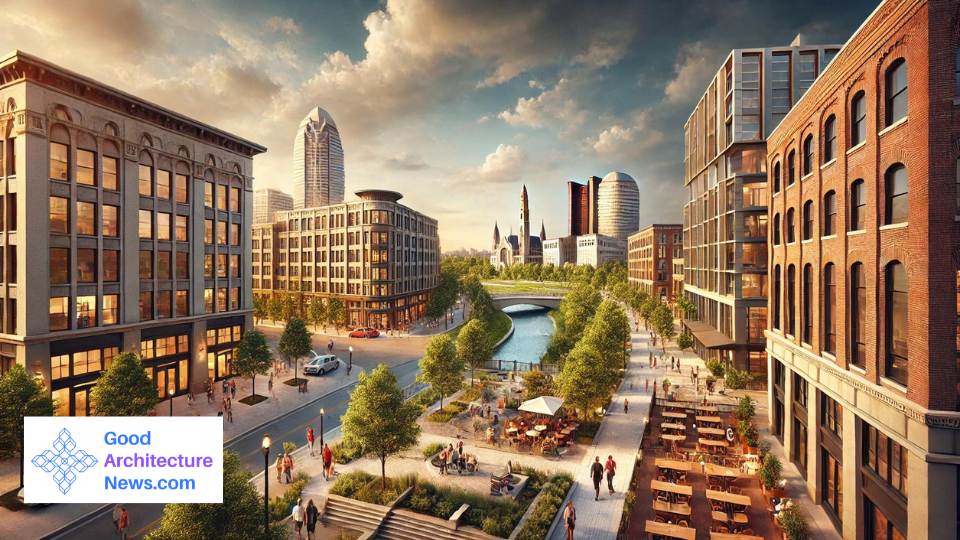Columbus, Indiana’s American Modern Architecture: A Living Legacy
Modernist Marvels: How Saarinen, Pei, and Meier Shaped Columbus, Indiana
A small Midwestern city called Columbus, Indiana, may not seem like the most likely location to find some of the most important examples of modern American architecture. Nevertheless, this modest hamlet has emerged as a symbol of American modernism, presenting an astounding array of architectural wonders that have made it known as a destination for design enthusiasts. Columbus, sometimes called the “Athens of the Prairie,” is a living example of the strength of forward-thinking leadership, the value of community involvement, and the long-lasting influence of modernist architectural design.
Note – Copyright of the videos embeded in this blog belongs to respetive filmmakers and the channels. I might remove them if asked to in future.
The Origins of a Modernist Center
The local engine manufacturer, Cummins Inc., was directed by philanthropist and businessman J. Irwin Miller, who initiated the process of transforming Columbus into an architectural icon.
Miller thought that great architecture could improve the standard of living in his hometown and make the people there feel a feeling of pride and community.
The foundation for an ambitious architectural program that would draw some of the most well-known architects of the 20th century was laid by this belief.
Miller and his spouse, Xenia Simons Miller, established the architectural program at the Cummins Foundation in 1957. If the designs for public buildings in Columbus came from a list of architects the foundation had authorized, the foundation offered to pay the architectural fees for those buildings. Prominent figures who helped shape the city’s skyline, including Richard Meier, I.M. Pei, Robert Venturi, and Eero Saarinen, were drawn to this endeavor.
The First Christian Church by Eero Saarinen
When the First Christian Church was finished in 1942, Eero Saarinen’s design became one of the city’s most recognizable and early additions to its architectural environment. The church broke with traditional ecclesiastical architecture with its bold, clean lines and use of contemporary materials including brick, glass, and steel. Saarinen’s design established the standard for upcoming modernist construction in the city by emphasizing utility, simplicity, and a sense of community.
The First Christian Church was a testament to modernism’s ability to change not just buildings but the urban landscape overall with its asymmetrical tower and horizontal lines. It continues to be a focal point of Columbus’ architectural history, exemplifying the creativity, order, and clarity that characterize contemporary design.
Cleo Rogers Memorial Library by I.M. Pei
The Cleo Rogers Memorial Library in Columbus, which I.M. Pei designed and finished in 1969, is another important piece of architecture. Pei, who is renowned for his exacting geometric designs and careful blending of buildings into their environments, built a library that functions as a facility and a symbol of local pride.
Huge glass sections, a dramatic use of red brick, and a grandiose attitude that encourages community involvement are all hallmarks of the library’s architecture. Henry Moore’s “Large Arch” sculpture is part of the nearby public plaza, which Pei also built. Together, they create a dynamic public area that blurs the lines between art, architecture, and community life.
Pei’s work in Columbus is a prime example of the modernist idea that architecture has the power to influence municipal identity and social interaction. The Cleo Rogers Memorial Library is a testament to the community’s dedication to both superior architectural design and cultural enrichment.
Architectural Continuity in Columbus
Columbus’ commitment to modernist architecture extended beyond Pei and Saarinen’s achievements. Other notable architects contributed to the city’s architectural development with projects like Robert Venturi’s 1971 design for Fire Station No. 4 and Richard Meier’s 1973 design for the Cummins Corporate Office Building.
Meier’s Cummins Corporate Office Building, with its white, rectilinear shape and generous use of glass producing a sense of openness and connectedness, is a study in light and transparency. Contrarily, Venturi’s Fire Station No. 4 is a whimsical yet practical structure that defies modernity and fire station design norms, illustrating Venturi’s conviction in the “complexity and contradiction” of architecture.
These structures, like a lot of other ones in Columbus, add to a unified urban fabric that is both unmistakably modern and firmly anchored in the neighborhood. Because of the city’s architectural continuity, modernist concepts can be found in a living laboratory where buildings interact with one another to create a dialogue that crosses decades and architectural styles.
Miller House and Garden
The Miller House and Garden, created by Eero Saarinen and including interior design by Alexander Girard and landscape architecture by Dan Kiley, is a key piece of architecture in Columbus. One of the most well-known examples of modern residential architecture in the US is this private home, which was finished in 1957.
The modernist principles of openness, simplicity, and harmony with nature are personified in the Miller House. The open floor layout of Saarinen’s design blurs the lines between indoor and outdoor areas, and it has a flat roof and large glass walls. Together with Kiley’s carefully planned gardens, Girard’s colorful interior design offers a peaceful space that honors the Millers’ refined taste and modernist values.
The Miller House and Garden is a representation of the Millers’ continuing influence in Columbus as well as a monument to the cooperation of some of the most significant designers of the 20th century. It continues to be an important architectural and cultural landmark, providing a window into the creative and personal vision that created the city’s architectural identity.
Columbus’s Modernist Heritage Columbus, Indiana, is still a global hub for modernist architecture today, drawing in visitors from academia, the architectural community, and fans of the style. Modernist architects like Deborah Berke, who created the Irwin Conference Center, and Kevin Roche, whose design for the Cummins Columbus Engine Plant exemplifies the development of modernist concepts in the twenty-first century, have contributed to the city’s architectural landscape.
Columbus’ dedication to high-quality architecture has also served as an inspiration for continuous initiatives to highlight and conserve its modernist past. The city’s 2000 designation as a National Historic Landmark District emphasizes how important it is to preserve this special legacy for future generations as well as the value of its architectural contributions.
Architects of Columbus, Indiana
Kindly email us if you find the data is wrong.
| Architect | Notable Contribution | Year | Description |
|---|---|---|---|
| Eliel Saarinen | First Christian Church | 1942 | Marked the beginning of Columbus’s transformation into a modernist hub. |
| Eero Saarinen | Irwin Union Bank, Miller House, North Christian Church | 1954, 1957, 1964 | Contributed significantly to the city’s modernist architecture. |
| I.M. Pei | Cleo Rogers Memorial Library | 1969 | Created a civic landmark that enhanced the urban fabric of the city. |
| Kevin Roche | Cummins Corporate Office Building, Columbus Post Office | Various | Added to the corporate and civic architecture of Columbus. |
| Harry Weese | First Baptist Church | 1965 | Known for designing this significant church in Columbus. |
| Robert Venturi | Fire Station No. 4 | 1967 | Early example of postmodern architecture. |
| Richard Meier | Clifty Creek Elementary School | 1982 | Recognized for his distinct style in this educational facility. |
| Edward Bassett (SOM) | Columbus City Hall | 1981 | Modern civic architecture with respect to historical surroundings. |
| Michael Van Valkenburgh | Mill Race Park | 1980s | Integrated modern landscape architecture into the city’s design. |
Columbus, Indiana, an architectural innovation model
One amazing example of how a small American community can become a global hub for architectural innovation is Columbus, Indiana. Columbus, by virtue of the visionary leadership of individuals such as J. Irwin Miller and the talents of internationally recognized architects, has embodied the principles of American modernism and created an urban environment that is both inspiring and useful.
Columbus is a shining example of how design can improve communities, instill civic pride, and have a long-lasting influence on the cultural landscape as we look to the future. Columbus, a city in the Midwest, continues to serve as a live example of the transformational potential of modernist architecture, providing guidance and motivation for other communities globally.
Venkat

